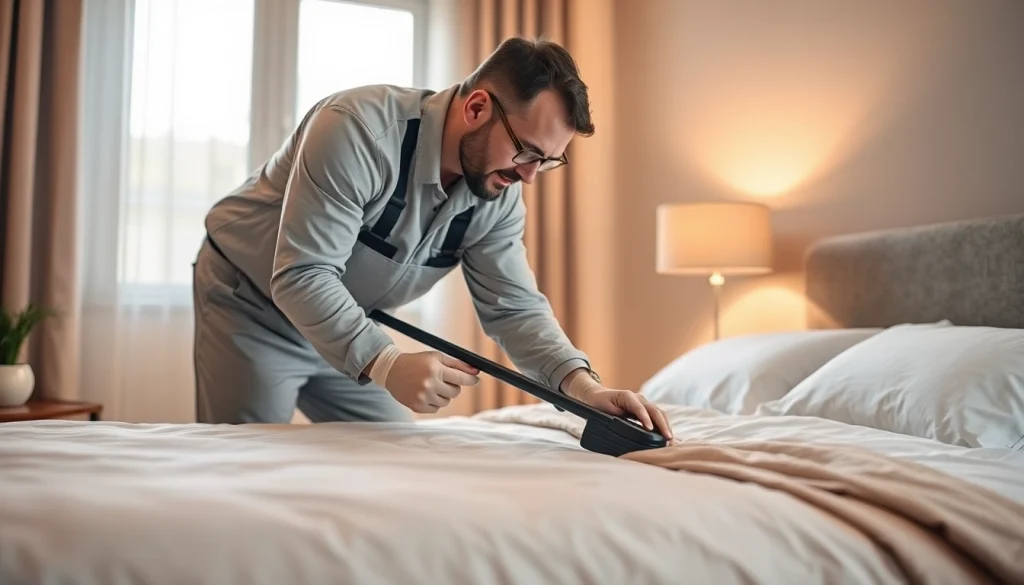Effective Bed Bug Removal Strategies to Regain Your Peace of Mind

Understanding Bed Bugs and Their Behavior
What Are Bed Bugs?
Bed bugs are small, elusive insects that belong to the Cimex lectularius species. They are ectoparasites that primarily feed on blood, particularly human blood, which makes them infamous as pests. Adult bed bugs are typically between 4 to 5 millimeters long and have a flat, oval shape. They are reddish-brown in color, becoming darker and more swollen after feeding, making them relatively easy to identify when spotted. Despite their name, bed bugs are not strictly limited to being found in beds. They can inhabit any area of a home, including furniture, carpets, and even electrical outlets.
Signs of Infestation
- Visible Bugs: The most obvious sign is seeing the bugs themselves. Adult bed bugs can be detected in the seams of mattresses, under bed frames, and in cracks of walls.
- Bed Bug Bites: Small, red, itchy welts on the skin may indicate an infestation. These bites often appear in clusters.
- Fecal Stains: Bed bugs leave tiny dark spots on sheets and in their hiding places, which are remnants of digested blood.
- Molted Skins: As bed bugs grow, they shed their exoskeletons, and these skins can often be found in areas they inhabit.
- Unpleasant Odor: A musty odor, often described as sweet or pungent, may indicate a larger infestation.
Why Bed Bug Removal is Crucial
Bed bug infestations pose significant health and psychological risks. Their bites can lead to allergic reactions, secondary infections, and intense sleep disturbances, which collectively impair the quality of life. Furthermore, the stigma surrounding bed bugs can affect personal relationships and self-esteem. As such, understanding effective bed bug removal techniques is vital to regaining control of your living space and ensuring that your home remains a safe and peaceful environment.
DIY Bed Bug Removal Techniques
Preparation: Safety First
Before undertaking any DIY bed bug removal, preparation is crucial. Begin by clearing the affected areas. Remove bedding and clothing and wash them in hot water (at least 120°F) to kill any bed bugs and their eggs. Dry them on the highest heat setting for added safety. Vacuum the entire room thoroughly, focusing on the mattress seams, baseboards, and carpet edges. Always dispose of your vacuum bag immediately in an outdoor trash can to prevent any potential escape.
Heat and Cold Treatments
Heat and cold treatments are effective methods for eliminating bed bugs. High temperatures can kill bed bugs at all life stages. Utilizing a steam cleaner on furniture, carpets, and mattresses at temperatures exceeding 120°F can effectively eradicate hiding bugs. Alternatively, you can freeze infested items by placing them in a freezer set to 0°F for at least four days, ensuring that all stages of the bed bug life cycle are targeted.
Physical Removal Strategies
To physically remove bed bugs, consider using mattress encasements, which trap bugs and prevent them from entering the mattress. These encasements must be left on for at least a year to ensure that any remaining insects die off. Additionally, diatomaceous earth—a naturally occurring powder—can be sprinkled in areas where bed bugs are present. This powder works by dehydrating the bugs and has been shown to be a highly effective method of removal.
Professional Bed Bug Removal Services
What to Expect from Exterminators
When opting for professional extermination, you can expect a thorough evaluation of your home from trained pest control specialists. They will inspect your living space, assessing various areas for signs of infestation. Most exterminators use an Integrated Pest Management (IPM) approach, which includes monitoring, identifying the pest problem, and implementing a combination of non-chemical and chemical treatments as necessary.
Cost of Professional Treatments
The average cost of professional bed bug removal can range considerably based on the severity of the infestation and the services provided. Homeowners can expect to pay anywhere from $300 to $1,500, depending on the size of the infestation and the treatment methods used. Heat treatments, for instance, can be more expensive due to the equipment used, while traditional chemical treatments may be less costly but require follow-up visits.
Choosing the Right Service Provider
When selecting an exterminator, it’s essential to conduct thorough research. Look for providers that are licensed and insured, read reviews, and ask for referrals from friends or family who have dealt with similar issues. It’s important to ensure the extermination plan includes follow-up visits, as bed bugs can be notoriously difficult to eradicate completely.
Preventing Future Infestations
Keeping Your Home Bug-Free
Preventing future bed bug infestations involves a proactive approach. Ensure that your home is clutter-free, as clutter provides ample hiding spots for bed bugs. Regularly vacuum and clean spaces that may harbor these pests. Inspect secondhand furniture or clothing before bringing them into your home. Additionally, encase mattresses and box springs in protective covers to minimize potential re-infestation.
Travel Tips to Avoid Bed Bugs
Traveling can increase your chances of encountering bed bugs. Always inspect hotel rooms upon entering for any signs of bed bugs. Keep your luggage off the floor and use a luggage rack if possible. When returning home, wash all clothes in hot water, even items that were not worn, to eliminate any trapped bugs. Keeping essential travel hygiene practices can go a long way in preventing bed bugs from hitching a ride back home with you.
Regular Maintenance and Inspections
Regularly inspecting your home—especially areas that are more prone to infestations—can help detect bed bugs early. Setting up a routine maintenance schedule with pest control services can also provide peace of mind and ensure that your home remains bug-free. Simple practices like inspecting furniture, and mattress seams, and looking out for any signs of bed bugs can play a crucial role in early detection.
Frequently Asked Questions About Bed Bug Removal
Can I Do It Myself?
Yes, it is possible to remove bed bugs yourself, especially if the infestation is at an early stage. It requires diligence and patience, as multiple treatments may be needed to entirely eliminate them. Utilizing a combination of heat treatments, vacuuming, and potentially some effective pesticides can yield positive results. However, if the infestation is severe, it is advisable to seek professional help.
What Chemicals Are Safe to Use?
Many options are available for bed bug treatment in terms of pesticide chemicals; however, it is crucial to choose those that are specifically labeled for bed bugs and safe for indoor use. Products containing pyrethroids, for example, are commonly recommended. Always read the packaging carefully and follow instructions to ensure safety for both humans and pets.
How to Handle Bed Bug Bites
Most bed bug bites do not require medical treatment, as they typically resolve on their own within a week or two. However, to alleviate itching and discomfort, over-the-counter antihistamines like diphenhydramine can be helpful. Additionally, topical creams containing hydrocortisone may help with inflammation. If an allergic reaction or infection occurs, consulting a healthcare provider is recommended.






